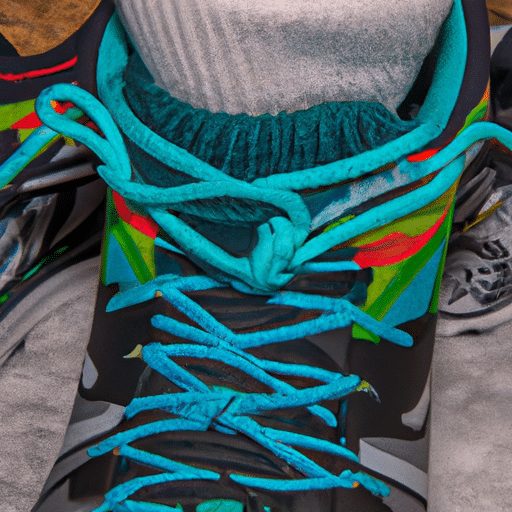When preparing for a hiking adventure, choosing the proper footwear is crucial. And while we often focus on the shoes, we overlook the importance of socks.
But here’s the burning question: should we wear thicker socks with our hiking shoes? In this article, we’ll explore the benefits of opting for thicker socks and how they can enhance our overall hiking experience.
So, if you’re gearing up for your next outdoor expedition, keep reading to discover whether thicker socks are the right choice.
Benefits of Wearing Thicker Socks
When it comes to hiking, wearing the right socks can make a difference in comfort and performance. Thicker socks offer several advantages that can significantly enhance your hiking experience.
Improved insulation
One of the significant benefits of wearing thicker socks is improved insulation. Thicker socks provide an additional layer of warmth, which can be especially valuable when hiking in colder temperatures or during the winter months. The extra insulation helps to keep your feet cozy and comfortable, preventing them from becoming excessively cold and reducing the risk of frostbite or discomfort. With improved insulation, you can enjoy your hike without worrying about numb toes or discomfort due to the cold.
Extra cushioning and comfort
Thicker socks also offer enhanced cushioning and comfort. The additional padding provided by these socks helps to absorb impact and alleviate pressure on your feet. This is particularly beneficial when hiking on rugged terrains or spending long hours on your feet. The cushioning effect of thicker socks helps reduce fatigue and prevent foot pain, allowing you to enjoy your hike for extended periods without discomfort.
Better moisture-wicking
Moisture-wicking is another advantage of wearing thicker socks. Hiking often involves physical exertion and can result in sweaty feet, leading to dampness and potential discomfort. Thick socks made from moisture-wicking materials such as merino wool or synthetic fibers help to pull moisture away from the skin and promote evaporation actively. This ensures that your feet stay dry and comfortable, minimizing the chances of blisters, hot spots, or fungal infections.
Reduced friction and blisters
Thicker socks can also help to reduce friction and prevent blisters. When hiking, the continuous rubbing and friction between your foot and the shoe can lead to painful blisters. Thicker socks act as a buffer between your foot and the shoe, minimizing the chances of friction and reducing the risk of blisters. Additionally, the extra cushioning provided by these socks helps to alleviate pressure points and prevents the formation of painful hot spots.
Considerations for Thicker Socks
While thicker socks offer numerous benefits, there are several considerations to consider before incorporating them into your hiking gear.
Proper fit of shoes
When wearing thicker socks, it is essential to ensure that your shoes fit properly. The added thickness can alter the fit of your shoes, leading to discomfort or even potential foot issues. Try on your shoes with thicker socks to ensure enough room for your feet without feeling too tight or loose. Finding the right combination of shoes and socks will help prevent blisters, hot spots, or other discomforts during your hike.
Temperature and weather conditions
Choosing thicker socks also depends on the temperature and weather conditions you will be hiking. For colder temperatures, thicker socks are more suitable to provide the necessary insulation. However, thicker socks may cause your feet to feel excessively hot and sweaty in warmer weather. Considering the forecasted weather and selecting socks accordingly is essential to optimize comfort and performance.
Type of hiking activity
The type of hiking activity you plan to engage in is another essential factor to consider when deciding on the thickness of your socks. For shorter day hikes on well-maintained trails, thinner socks may be sufficient to provide comfort and support. However, thicker socks offer additional cushioning and protection for backpacking or multi-day hikes involving heavier loads or traversing challenging terrains. It is crucial to assess the demands of your hiking activity and choose socks that meet those requirements.
Personal preference
Ultimately, personal preference plays a significant role in determining whether thicker socks suit you. Some hikers may find the extra cushioning and insulation provided by thicker socks incredibly comfortable, while others may prefer a thinner, more lightweight option. Listening to your feet and choosing socks that are comfortable and conducive to an enjoyable hiking experience is essential.
Finding the Right Thickness
Selecting the right thickness of socks is essential for maximizing comfort and performance during your hikes. Here are a few factors to consider when determining the appropriate thickness:
Material composition
The material composition of the socks can significantly influence their thickness. Different materials offer varying levels of insulation and cushioning. Popular materials for hiking socks include merino wool, synthetic fibers, cotton, and blends. Each material has its unique properties, so it is essential to consider the benefits and drawbacks of each when selecting the thickness of your socks.
Sock thickness ratings
Many sock manufacturers provide thickness ratings to help hikers choose the right socks. These ratings typically range from light to heavy or cushioned, allowing hikers to select socks based on their preferences and hiking conditions. Sock thickness ratings provide a valuable indication of the cushioning level and insulation the socks provide.
Experimentation and trial
Finding the right sock thickness often requires some experimentation and trial. Every hiker’s feet and preferences differ, and what works for one person may not. It can be helpful to try on socks of different thicknesses and materials during shorter hikes or trial runs to determine which combination offers you the best comfort and performance.
Consulting with experts or experienced hikers
If you are unsure about the appropriate sock thickness for your hiking needs, seeking advice from experts or experienced hikers can be beneficial. They can offer valuable insights and recommendations based on their experiences and expertise. Listening to their advice and considering their suggestions can help you make an informed decision when choosing the right thickness for your hiking socks.
Choosing the Right Sock Material
In addition to thickness, the material of your hiking socks is also crucial for ensuring comfort and performance. Here are some common sock materials to consider:
Merino wool
Merino wool is famous for hiking socks due to its excellent moisture-wicking properties, odor resistance, and thermal regulation. It provides warmth in colder temperatures while still offering breathability to prevent overheating. Merino wool socks are also known for their softness and comfort.
Synthetic fibers
Synthetic fibers such as nylon, polyester, and acrylic are commonly used in hiking socks. These materials are lightweight, durable, and offer good moisture-wicking capabilities. Additionally, synthetic socks tend to dry quickly, making them suitable for hikers who may encounter wet conditions.
Cotton
While cotton socks are comfortable and affordable, they are not recommended for hiking, especially in colder or wet conditions. Cotton tends to absorb moisture and hold onto it, resulting in a damp and uncomfortable environment for your feet. Cotton socks are more prone to blisters and can contribute to foot odor due to their lack of moisture-wicking capabilities.
Blends
Many hiking sock options come in blends of different materials to offer a combination of their respective benefits. For example, a merino wool blend may provide the warmth and moisture-wicking properties of merino wool with added durability and stretch from synthetic fibers. These blends offer a balance between comfort, functionality, and performance.
Importance of Proper Fit
Regardless of sock thickness or material, ensuring a proper fit is crucial for overall foot comfort and support during hiking. Here are some considerations for achieving the right fit:
Sizing up or down
When wearing thicker socks, you may need to adjust the size of your hiking shoes accordingly. Thicker socks can make your feet snugger in the shoes, so sizing up by half a size or more may be necessary to accommodate the added thickness and prevent discomfort or blisters.
Leaving space for toe movement
Wearing thicker socks is essential to have adequate space for toe movement. Your toes should be able to wiggle freely without feeling crowded or constricted. This helps to prevent friction and ensures proper blood circulation, keeping your feet comfortable and reducing the risk of foot issues.
Proper arch and heel support
Thicker socks can alter the fit of your shoes, particularly the arch and heel area. Ensuring that the socks properly support these areas is essential, as inadequate support can lead to foot fatigue, discomfort, and potential injuries. Look for socks with built-in arch and heel support, or consider using additional insoles or orthotics if needed.
Avoiding excess tightness
While it is essential to have a snug fit, it is equally important to avoid excessive tightness. Tight socks can restrict blood circulation and cause discomfort or pain, especially during long hikes. Ensure that the socks fit comfortably without feeling overly tight or constricting.
Temperature and Weather Considerations
The temperature and weather conditions in which you will be hiking play a significant role in determining the thickness of your socks. Here are some considerations based on different weather conditions:
Cold weather hiking
In cold weather, thicker socks are generally preferred to provide insulation and keep your feet warm. Layering with thinner moisture-wicking socks underneath thicker ones can help maintain optimal warmth while ensuring moisture management. It is essential to balance warmth and breathability to avoid sweaty or icy feet.
Warm weather hiking
In warmer weather, thinner socks are generally more suitable to promote breathability and prevent overheating. Thin and lightweight moisture-wicking socks help to keep your feet cool and dry, reducing the risk of blisters and discomfort from excessive sweating. It is important to choose socks that offer sufficient cushioning and support while still allowing for adequate ventilation.
Type of Hiking Activity
The type of hiking activity you plan to engage in also plays a role in determining the thickness of your socks. Here are some considerations based on different types of hiking activities:
Day hikes
Thinner socks are often sufficient to provide comfort and support for shorter day hikes on well-maintained trails. These hikes typically involve less stress on the feet and do not require the same padding and protection as longer or more challenging hikes.
Backpacking
For backpacking trips that involve carrying heavier loads and long hours of hiking, thicker socks with extra cushioning are beneficial. The additional padding helps to absorb impact and reduce foot fatigue, providing enhanced comfort and support.
Technical or rocky terrains
Hiking on technical or rocky terrains can be more demanding on the feet. Thicker socks with additional cushioning and protection are recommended to provide adequate shock absorption and prevent discomfort or injuries from uneven or jagged surfaces.
Multi-day hikes
Multi-day hikes, especially those involving camping and extended time on the trail, require socks that can handle prolonged wear and provide optimal comfort. Thicker socks with moisture-wicking properties and excellent cushioning are ideal for multi-day hikes, as they help prevent blisters, hot spots, and foot fatigue.
Personal Preference
Ultimately, personal preference plays a significant role in determining whether thicker socks are the right choice for you. Here are some factors related to personal preferences:
Individual comfort
Every hiker has unique preferences and comfort levels. Some hikers may find the extra cushioning and insulation provided by thicker socks extremely comfortable and beneficial, while others may prefer a thinner, more lightweight option. It is essential to consider what feels most comfortable and supports your needs.
The feeling of control and stability
Thicker socks may provide a more incredible feeling of control and stability on the trail for some hikers. The added cushioning and snug fit can enhance the connection between your feet and shoes, giving you a more secure and confident footing. If you value this sense of stability, thicker socks may be your choice.
Previous experience and familiarity
Your previous hiking socks experience and familiarity with different materials and thicknesses may also influence your preference. If you have had positive experiences with thicker socks in the past, you may feel more inclined to continue using them. Likewise, if you have discomfort or issues with thicker socks, you may opt for thinner alternatives.
Avoiding Common Issues with Thicker Socks
While thicker socks offer numerous benefits, hikers may encounter some common issues. Being aware of these issues can help you avoid or mitigate them:
Toe crowding
Thicker socks can sometimes cause toe crowding, particularly if your shoes are not sized appropriately. This can result in discomfort, blisters, or even toenail issues. Ensuring adequate space for your toes and appropriately sized shoes can help prevent this issue.
Reduced breathability
Thicker socks may have reduced breathability compared to thinner options, potentially leading to sweaty or excessively hot feet. Choosing socks made from moisture-wicking materials, like merino wool or synthetic fibers, is essential to maintain breathability and manage moisture effectively.
Incompatibility with certain shoes
Thicker socks may not be compatible with certain types of shoes. Some shoes, especially those with a snug fit or minimalistic design, may not have enough room to accommodate the added thickness. Testing the combination of shoes and socks before hiking is essential to ensure compatibility and avoid discomfort.
Increased drying time
Thicker socks often take longer to dry than thinner moisture-wicking options. If your hike encounters wet conditions, it is essential to consider this factor and potentially bring an extra pair of socks to change into if needed. Keeping your feet dry helps to prevent discomfort and blisters.
Conclusion
Choosing the right thickness of socks for hiking is essential for ensuring comfort, performance, and foot health. Thicker socks offer improved insulation, extra cushioning, better moisture-wicking, and reduced friction and blisters.
When selecting the appropriate thickness, it is essential to consider factors such as the proper fit of shoes, temperature, weather conditions, type of hiking activity, personal preference, and the type of sock material.
Considering these considerations, you can find the perfect balance between comfort and functionality, allowing you to enjoy your hiking adventures. So, next time you gear up for a hike, don’t forget to give your feet the support and comfort they deserve with the right thickness of socks!








































